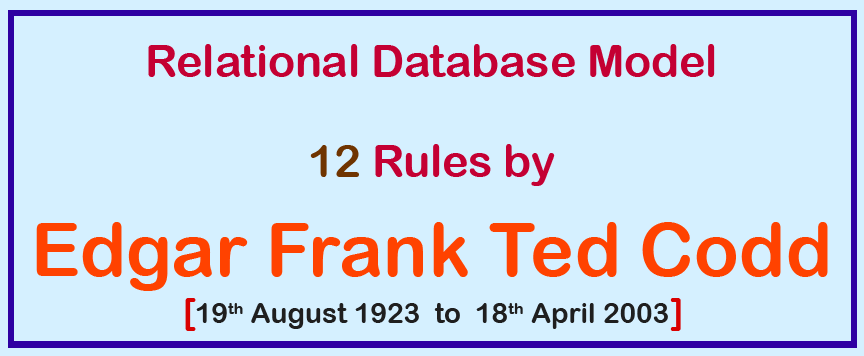Codd's 12 rules
Codd's Rules for RDBMS
Dr. Edgar Frank Codd (August 19, 1923 – April 18, 2003) was a computer scientist while working for IBM he invented the relational model for database management ( theoretical basis for relational databases). Codd proposed thirteen rules (numbered zero to twelve) and said that if a Database Management System meets these rules, it can be called as a Relational Database Management System. These rules are called as Codd's12 rules. Hardly any commercial product follows all.

Rule Zero
- The system must qualify as relational, as a database, and as a management system. For a system to qualify as a relational database management system (RDBMS), that system must use its relational facilities (exclusively) to manage the database.
- The other 12 rules derive from this rule. The rules are as follows :
Rule 1 : The information rule: All information in the database is to be represented in one and only one way, namely by values in column positions within rows of tables.
Rule 2 : The guaranteed access rule: All data must be accessible. This rule is essentially a restatement of the fundamental requirement for primary keys. It says that every individual scalar value in the database must be logically addressable by specifying the name of the containing table, the name of the containing column and the primary key value of the containing row.
Rule 3 : Systematic treatment of null values: The DBMS must allow each field to remain null (or empty). Specifically, it must support a representation of "missing information and inapplicable information" that is systematic, distinct from all regular values (for example, "distinct from zero or any other number", in the case of numeric values), and independent of data type. It is also implied that such representations must be manipulated by the DBMS in a systematic way.
Rule 4 : Active online catalog based on the relational model: The system must support an online, inline, relational catalog that is accessible to authorized users by means of their regular query language. That is, users must be able to access the database's structure (catalog) using the same query language that they use to access the database's data.
Rule 5 : The comprehensive data sub language rule: The system must support at least one relational language that
1. Has a linear syntax
2. Can be used both interactively and within application programs,
3. Supports data definition operations (including view definitions), data manipulation operations (update as well as retrieval), security and integrity constraints, and transaction management operations (begin, commit, and rollback).
Rule 6 : The view updating rule: All views those can be updated theoretically, must be updated by the system.
Rule 7 : High-level insert, update, and delete: The system must support set-at-a-time insert, update, and delete operators. This means that data can be retrieved from a relational database in sets constructed of data from multiple rows and/or multiple tables. This rule states that insert, update, and delete operations should be supported for any retrievable set rather than just for a single row in a single table.
Rule 8 : Physical data independence: Changes to the physical level (how the data is stored, whether in arrays or linked lists etc.) must not require a change to an application based on the structure.
Rule 9 : Logical data independence: Changes to the logical level (tables, columns, rows, and so on) must not require a change to an application based on the structure. Logical data independence is more difficult to achieve than physical data independence.
Rule 10 : Integrity independence: Integrity constraints must be specified separately from application programs and stored in the catalog. It must be possible to change such constraints as and when appropriate without unnecessarily affecting existing applications.
Rule 11 : Distribution independence: The distribution of portions of the database to various locations should be invisible to users of the database. Existing applications should continue to operate successfully :
1. when a distributed version of the DBMS is first introduced; and
2. when existing distributed data are redistributed around the system.
Rule 12: The non-subversion rule: If the system provides a low-level (record-at-a-time) interface, then that interface cannot be used to subvert the system, for example, bypassing a relational security or integrity constraint.
Check out our 1000+ SQL Exercises with solution and explanation to improve your skills.
Previous: SQL Syntax
Next: The Components of a Table
